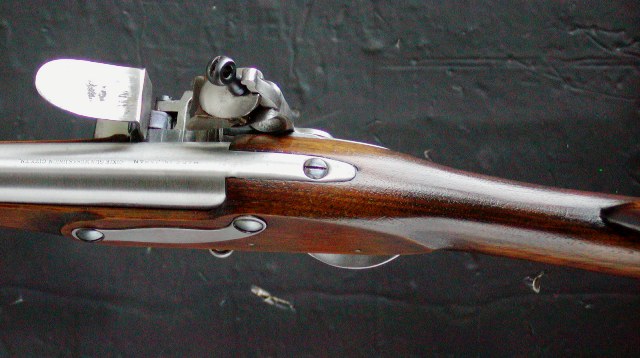Seeing as how I've got a Charleville on my "wanna" list I took note of a used Miroku made in Japan Dixie Gun Works branded 1766 Charleville currently offered on Gunbroker. It's in pretty rough shape, but nothing I couldn't deal with, if I could snag it at a reasonable price. But I'm unfamiliar with Miroku. I'd be comparing against a new Pedersoli kit. As far as Pedersoli, I know what I'm dealing with, as I've already done their kits. How does Miroku compare versus Pedersoli? What do I need to know to make an informed comparison and decision? Thanks.
Sorry, can't post link to GB auction here, but not that hard to find.
They’re both very different style muskets, even though they’re titled the same they’re not the same.
The miroku charleville, is as faithful and genuine a reproduction you can get to an original 1766, it’s slightly heavier than an original, but not by much. A miroku Charleville is patterned after a late model 1766, one that was made with a rear band spring but not stepped at the forearm like the later 1768 and 1769 variants.
Early model 1766’s had a friction fit rear and and a front band that had a slightly taper at the mouth, the one pictured below is an early model 1766.
The pedersoli 1763/66 is not an odd one to explain, it’s not really true to any specific pattern but has all of the size features of a heavy model 1763, mostly the stock.
Compared to an original 1766, the pedersoli musket is massive, everything is much larger, even the band springs.
The stock is more robust in the wrist and butt and forearm like a 1763, however doesn’t stay true to any real pattern. A 1763 had a high comb like the pedersoli however, the cross section of an original 1763 swelled significantly compared to it, The swell deeply defined the flutes. The wrist and butt were also slightly longer with a larger breech area to accommodate a barrel with a breech that was almost 1.575 tall and 1.55 wide. The originals I’ve measured are an average of 1.450 at the breech. The pedersoli breech is around 1.325”.
An original 1763 was in a minimum of .69 and maximum caliber of .72 with a barrel that tapered significantly from from breech to muzzle, the pedersoli barrel is pretty straight. Both barrels have a weight around 5lbs, the heaviest original I’ve weighed was 5.25 lbs with much of the weight being in breech up to 22”.
The barrel bands on the pedersoli 1763/66 dont’ match any pattern, they’re thick placed incorrectly, and add a lot of weight becuase they’re so needlessly heavier. An original 1763 musket had a unique barrel band system that used a long rammer guide that was riveted from the front band and sistered to the middle band. Sometimes called a spring, it acted more Ike a gutter or guide as the musket also had a rammer spoon pinned beneath the breech. An original 1763 middle and front band were 11 1/2 inches apart, a pedersoli has them set 14 1/2 inches apart, an original 1766 had them around 14” apart.
Ramrod on a 1763/66 pedersoli is not shapped right, they were button shaped and later models were trumpeted. The navy arms rammer is not too bad but would be a later pattern.
To add to the guns weight, the pedersoli sports a massive ramrod that weighs almost over 1lb, the total weight of a pedersoli 1763 is around 11lbs, the heaviest 1763 was around 10.25 lbs.
The pedersoli 1766 lock is massive, like an original 1763 however it is disproportionate in size to an original 1763. An original 1763 has larger springs, and a longer plate. The Italian pattern 1763 has very thick massive internals and smaller springs with a plate that is nearly 1/4 thick at 6 5/16 inches long compared to an original plate that is around 7” long.
The 1763 musket in my opinion was an experimental design that changed many times over before it was finalized int the 1766, some are very heavy to modestly heavy with some being the same weight as a 1766 musket. In the picture Below are two variants, an early 1763 from Marburge and one from charleville around 1764 with the last picture being a 1763/66 pedersoli.
Can a 1763/66 pedersoli be altered to a 1766…. I wouldn’t and have turned down the requests for many reasons, modifications to it would never really match an original within tolerances of what many call a 6ft test. A big reason is the butt stocks, french muskets had a slightly longer butt stock with a swelled cross section that can’t be easily distinguished from photos, you really need to hold an original to get a better understanding of its shape and feel. The lock on a pedersoli charleville is a few ounces too large, as are the bands and the trigger guard needs to be welded from two pieces into one. Ironically the sling swivels are too tiny compared to the originals.
In its original state a pedersoli 1763/66 is really a nice working quality musket. What I’ve done is made new springs, swapped out the frizzen and mainspring to a more french pattern and made a new top jaw screw, as Dave mentioned above. Otherwise reshaping the butt stock by reducting the comb is always an option. The forearms are bit complicated, in that the bands are so large and heavy, reducing the forstock woudln't be wise unless you were going to cut and weld the bands so they fit well after reducing the forestock.
A navy arms miroku charleville is close but still somewhat displaced in size but close enough.
The best option is to restock a navy arms musket from the factory birch stock to a walnut stock with the correct butt stock and forearm patterns for a 1766-1769 pattern (1769 pattern had moved the bayonet lug).











































